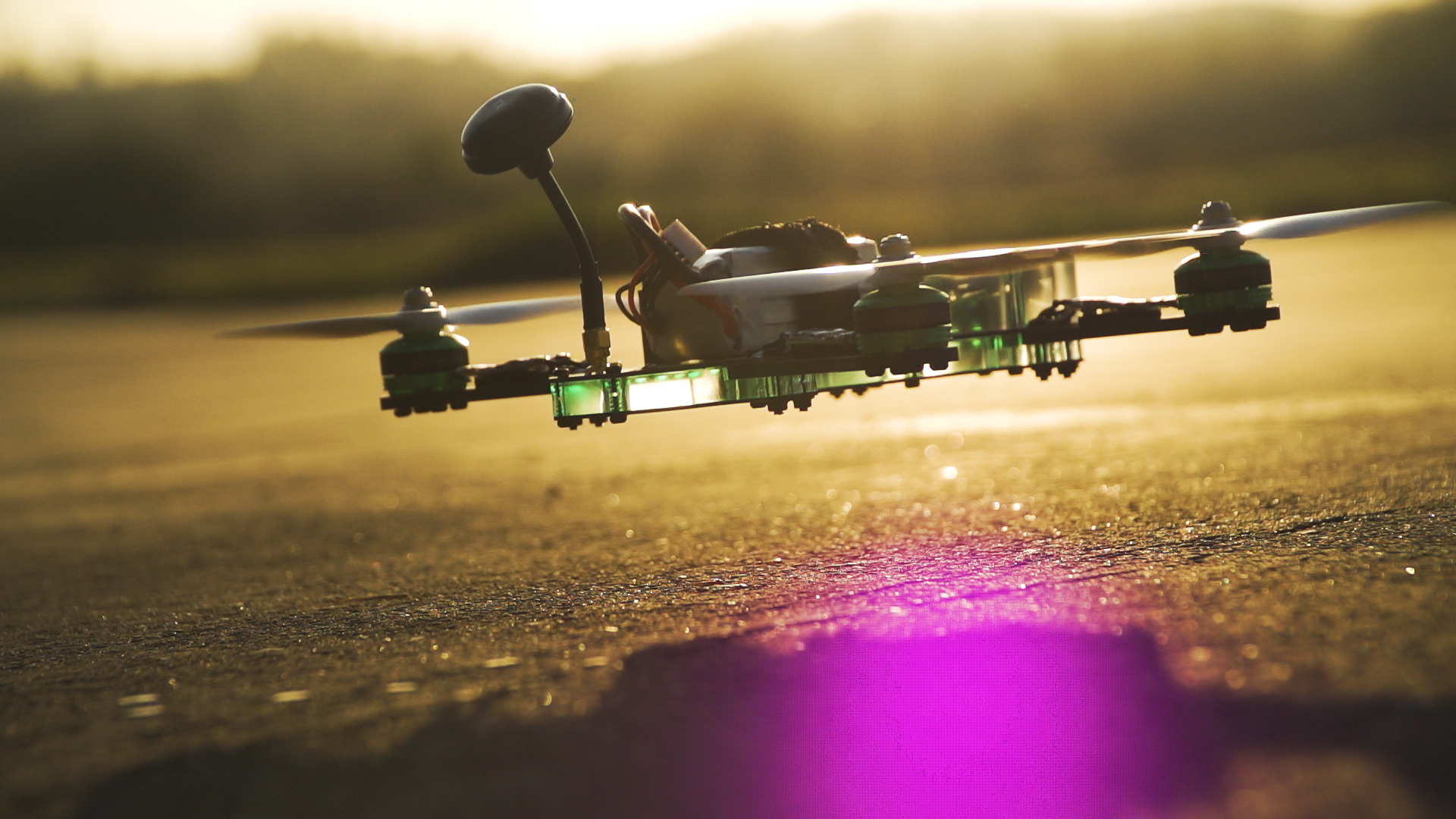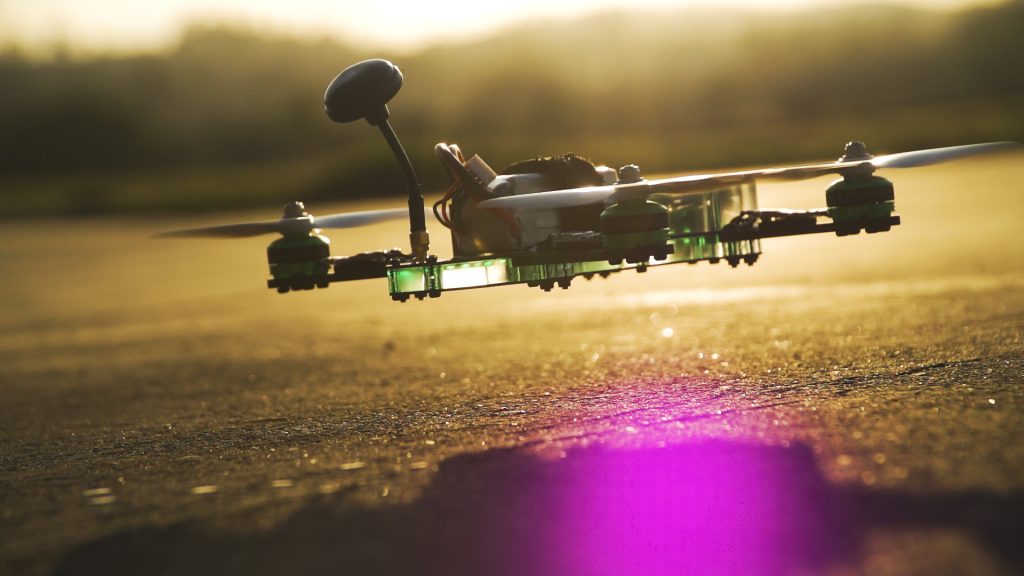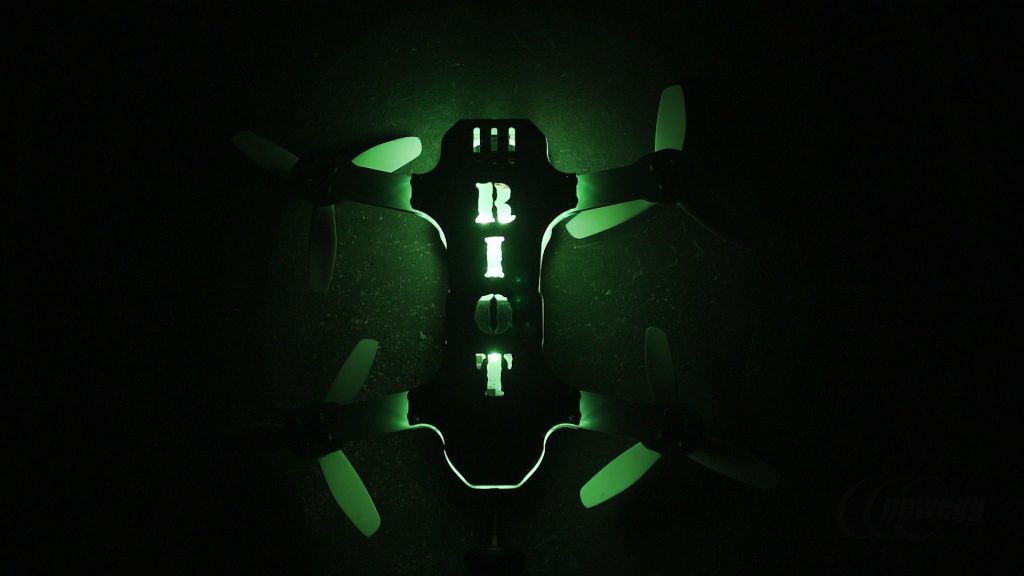

Technology will redefine the future of sports as we know them.
It’s not a prophecy derived from stargazing or a fanatical tech geek’s ranting, we have seen the beginnings of this journey play out before us already. Professional gaming leagues and the massive growth of fans has spawned an eSports community with mainstream legitimacy and big league corporate interest.
Drone racing is one of the newest tech sports to shake things up in a major way, combining the best aspects of a high-adrenaline spectator sport with the thrill of a first-hand VR gaming experience. Thrust UAV has brought their Riot 250R Pro to the forefront of this cutting edge, pushing the limits of consumer drone capabilities with breakneck speed.
Start a Riot
The Riot 250R Pro ($499) is the first production drone from Thrust UAV, designed to be a lightweight, durable racing drone that is easy to operate, and lay down some serious speed. Out of the box, the Riot is an almost-ready-to-fly drone, which means that you need to scoop up a pair of first-person-view (FPV) goggles, remote, receiver, and Lithium-polymer battery and you are ready to start ripping sky.
And sky it does rip. At speeds of 75mph+, this is one fast machine. The power comes from custom Thrust UAV tuned quad DYS SE2205 2550kv motors, with a multishot enabled DYS XM20 speed controller. Thrust notes that these motors are currently the biggest, fastest on any almost-ready-to-fly drone on the market. Keeping all this power on the right course is aided by the 2.8mm CCD flight camera with wide dynamic range, which is your first-hand view of the world from the drone sent straight to your goggles. When we tested this out we went with the FatShark Dominator V3 FPV goggles to receive the video feed, which are a pretty common choice for FPV pilots (although not cheap at around $340).
The Riot’s 250mm white gelcoat carbon fiber H-frame is designed to be ultra-durable and capable of surviving some hefty abuse (which it definitely faced at our hands). By using a white frame Thrust departs from the traditional black used by most in the racing drone industry, but the flash doesn’t end there. 52 customizable LEDs on the body of the Riot also add to the showmanship factor, which can be set individually via the Betaflight software. Even for someone who had never used the program before, it was pretty simple to change the color and blinking pattern of the lights, as well as to program the remote functions and set performance parameters.
Ride Along

Before taking the controls to pilot the drone myself, I went for a virtual ride along with one of Thrust UAV’s professional race pilots Hazak, donning a spare set of goggles. As a first-time FPV drone experience, it is very similar to the feeling of virtual reality. You get the same sensation of movement, and the experience is like being on a virtual roller coaster.
Through the double backflips and barrel rolls to stopping on a dime and then launching hundreds of feet into the air, my brain (and stomach) were thrilled by the exhilarating experience of being virtually onboard. Watching the world speed by from the nose of the drone is a unique experience that first-person gamers and flight simulator fans will definitely enjoy.
Taking the controls
Having flown a few different cruising drones myself, getting accustomed to the FPV style did have a learning curve. The hyper-responsive nature of the Riot 250R was something I was not used to, coming from the comparatively sluggish controls of the DJI Phantom 4 and others.
The immediate connection between remote input and drone movement is astonishing, and I could go from ground level to dizzying heights in mere seconds. Covering the horizontal axis the Riot was a lightning bolt from the hands of Zeus himself, closing the airfield length of 3/10 mile in no time. After witnessing the Riot streak across the sky, those customizable LEDs and white paint prove their practical use in keeping the drone in sight.
The carbon fiber frame serves a dual purpose, not only to lighten the weight of the UAV but also to increase the strength of the build to survive any naturally occurring abuse. The Riot repeatedly withstood drops from above 20 feet onto hard-packed dirt and grass, and it endured cartwheels across asphalt without so much as a chip to the coating or damaged arm, though I have gone through my fair share of propellers.
The Riot even took a direct line into a tree trunk, which resulted in 2/4 broken props and nothing more. Pretty tough little thing if you ask me. Thankfully, the propellers are cheap and easy to replace.
On the note of replacement parts, if you were to suffer severe damage to an arm there are two bolts and two soldered wires to remove, swap, and reverse to be back up and flying. Granted you probably won’t be carrying a soldering kit with you in the field, but damage isn’t a death sentence for the Riot. In fact, with the modular design, every component on the drone can be swapped out to upgrade, customize, or replace with little trouble.
Tips for New Drone Racers

Today’s racing drone industry is much friendlier to newcomers without a deep background in physics, engineering, or programming than in the past, when most machines were built by their pilot. Long hours of trial and error and systems testing have been replaced with ready-to-fly or almost-ready-to-fly options, but that isn’t to say the sport is by any means a cakewalk.
Being a racing drone, all the GPS-powered location services, auto takeoff/landing, locked hovering, and other features are stripped away to leave a lean, mean performance machine. What that means for the new pilot is that these drones can move quickly, and you’ll need to take extra care when operating. Although not entirely advised, I have flown out of the box drones from my front lawn through the neighborhood without any incident. With a racing drone that would be a very poor move, so take caution in choosing a proper and secure area.
Lithium polymer batteries like the ones recommended for the Riot (1300mAh 4S or 3S) come with a base storage charge, which keeps them stable. Out of the box, you need to charge them to proper levels before attempting to fly. These LiPo batteries are finicky; too low of a charge and they become over discharged, too high and they are not stable for storage-both of which can reduce battery life. They should NEVER be punctured or they can burst into flame. For more info on LiPo batteries check out this guide.
You’ll need to gather up a few components to get your drone into the air, and we used the suggested FrySky Taranis X9D Plus 2.4GHz radio. While this thing has more switches than an operator board, you can customize each to do specifically what you want, depending on your style of flying or comfort with the controls. While intimidating at first, using only the inputs you need quickly makes it a familiar extension of the experience.
For the DIYer

Although it isn’t necessary to come from a strong tech background to fly a racing drone, the Riot system and Betaflight program allow for ultimate tweaking and customization. Beyond the color customization and blinking pattern of the LEDs (which can be used to signal throttle input, battery levels, pitch adjustments and more) the software gets into the nitty gritty of drone performance.
The Betaflight control module gives you access to settings customizable based on your skill level. A good starting point is beginning in “angle” mode, which is what most quadcopter pilots are used to. This ensures that when you let go of the sticks the drone stays level. Within the interface you can control the limits of the angle mode, and I set mine to 30°. This is also important when keeping in mind FPV flight relies on the front-mounted camera for your visual control. You can boost this to a more advanced level of control in “rate” mode, which means that the controls on the remote dictate how quickly the quadcopter rotates. You can set the pitch, yaw, and roll rates to suit your preference and skill level which is great for getting acclimated to the sport.
Buy Thrust UAV Riot 250R Pro on Newegg
Racing into the Future

We are only scratching the surface of drone racing, and each month that passes the sport gets more mainstream attention. Organizations like Drone Racing League (DRL), DR1 Racing, Drone Sports Association (DSA), and MultiGP are all bringing legitimacy and standardization to the industry, which is now seeing the light of day on ESPN as a recognized sport.
FPV drone racing is a thrilling experience, and the Thrust UAV Riot 250R Pro is a monster of a machine that makes it easy for newcomers to get into the sport while giving the performance demanded of the competitive circuit. The future of sports is steeped in tech, and the next wave of change is powered by four propellers.
